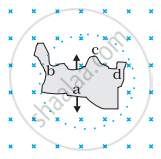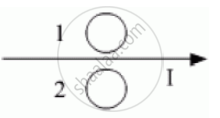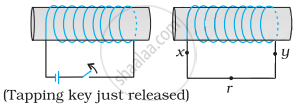Advertisements
Advertisements
Question
Same as problem 4 except the coil A is made to rotate about a vertical axis (figure). No current flows in B if A is at rest. The current in coil A, when the current in B (at t = 0) is counterclockwise and the coil A is as shown at this instant, t = 0, is ______.

Options
constant current clockwise.
varying current clockwise.
varying current counterclockwise.
constant current counterclockwise.
Solution
Same as problem 4 except the coil A is made to rotate about a vertical axis (figure). No current flows in B if A is at rest. The current in coil A, when the current in B (at t = 0) is counterclockwise and the coil A is as shown at this instant, t = 0, is constant current clockwise.
Explanation:
In this problem, Lenz’s law is applicable so let us introduce Lenz’s law first.
Lenz’s law gives the direction of induced emf/induced current. According to this law, the direction of induced emf or current in a circuit is such as to oppose the cause that produces it. This law is based upon law of conservation of energy.
When the current in coil B (at t = 0) is counter-clockwise and coil A is considered above it. The counterclockwise flow of the current in coil B is equivalent to north pole of magnet and magnetic field lines are eliminated upward to coil A. When coil A starts rotating at t = 0, the current in A is constant along a clockwise direction by Lenz’s rule.
APPEARS IN
RELATED QUESTIONS
Use Lenz’s law to determine the direction of induced current in the situation described by the figure:
A wire of irregular shape turning into a circular shape.

Predict the directions of induced currents in metal rings 1 and 2 lying in the same plane where current I in the wire is increasing steadily.

The battery discussed in the previous question is suddenly disconnected. Is a current induced in the other loop? If yes, when does it start and when does it end? Do the loops attract each other or repel?
A pivoted aluminium bar falls much more slowly through a small region containing a magnetic field than a similar bar of an insulating material. Explain.
Consider the situation shown in figure. If the switch is closed and after some time it is opened again, the closed loop will show ____________ .

A bar magnet is released from rest along the axis of a very long, vertical copper tube. After some time the magnet ____________ .
Which of the following statements is not correct?
Consider a metal ring kept (supported by a cardboard) on top of a fixed solenoid carrying a current I (Figure). The centre of the ring coincides with the axis of the solenoid. If the current in the solenoid is switched off, what will happen to the ring?

A long solenoid ‘S’ has ‘n’ turns per meter, with diameter ‘a’. At the centre of this coil we place a smaller coil of ‘N’ turns and diameter ‘b’ (where b < a). If the current in the solenoid increases linearly, with time, what is the induced emf appearing in the smaller coil. Plot graph showing nature of variation in emf, if current varies as a function of mt2 + C.
Predict the direction of induced current in the situation described by the following figure.

